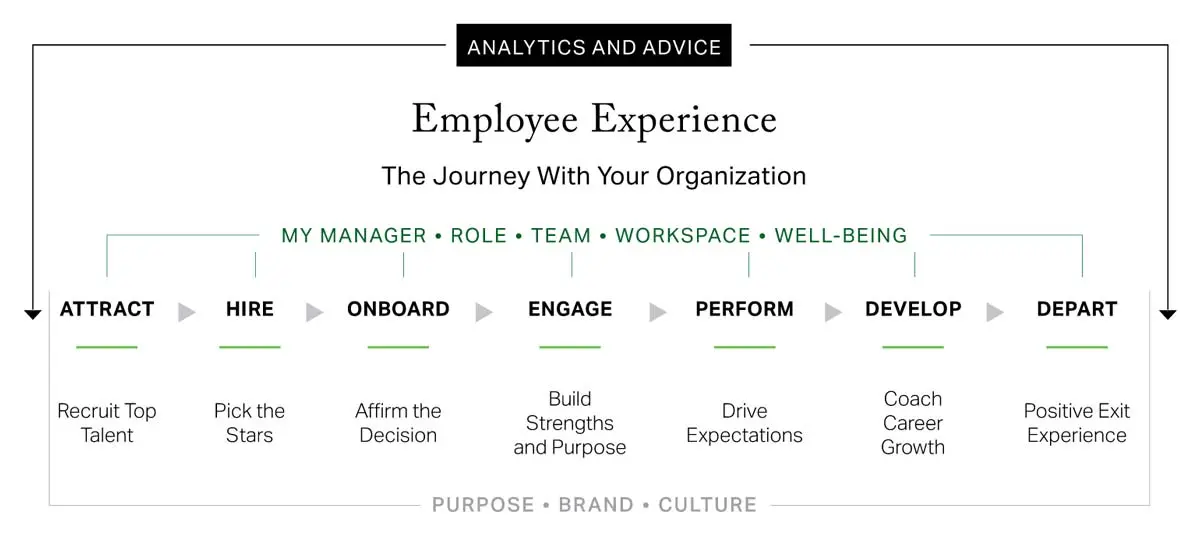Employee experience shapes how people feel about their work, their team, and their organization. Every interaction, from applying for a role to leaving the company, influences engagement and performance. The difference between thriving and surviving lies in the details: how quickly someone gets support, whether managers recognize contributions, if systems help or hinder progress.
Improving employee experience means identifying the moments that matter most and designing them intentionally.
This guide provides a practical framework to transform how people experience work at your organization. Through sustainable changes, you can create an environment that drives both individual fulfillment and company success.
What is Employee Experience?
Employee experience is the sum of every interaction an employee has with the organization, from the moment they discover the company to their final day at work. It includes formal processes, like onboarding and performance reviews, as well as informal moments, like day-to-day conversations with a manager.
It is not limited to perks or policies. Instead, it reflects how employees perceive their work, their relationships, and the support they receive to succeed. A positive employee experience creates clarity about expectations, builds trust between employees and leaders, and fosters motivation to contribute at a high level.
When designed with intention, employee experience becomes a powerful driver of engagement, retention, and company success.
Why Employee Experience is Important
Employee experience directly influences how people perform, how long they stay, and how they speak about the organization. Research from over 250 organizations shows that when employees feel supported and valued, they are more engaged in their work and more likely to contribute their best. This creates stronger teams and better business outcomes.
A thoughtful employee experience builds trust and confidence at every stage of the employee journey. It helps employees understand what is expected, see how their work connects to larger goals, and feel recognized for their contributions.
For L&D leaders, improving employee experience is also an opportunity to align learning and development efforts with what employees truly need.
Elevate’s 4-Step Employee Experience Design Framework

Improving employee experience requires a clear, focused approach. Many organizations try to fix everything at once or overlook the daily impact managers have on employees. A strong framework ensures efforts are targeted where they matter most, equipping managers to deliver a consistent and meaningful experience.
Elevate’s 4-step employee experience framework helps identify what truly needs work rather than what is simply the most visible. It supports managers in shaping daily interactions and directs resources toward changes that improve engagement and retention.
By following this framework, HR and People leaders can:
- Focus on what matters most to employees.
- Help managers deliver this experience every day.
- Channel resources where they have the greatest impact.
Step 1: Audit the Employee Lifecycle
The first step is to understand the experience employees actually have today. This begins by mapping the 7 stages of the employee lifecycle:

Source: https://www.gallup.com/workplace/323573/employee-experience-and-workplace-culture.aspx
Start by gathering data through interviews or focus groups with employees at different points in their journey, such as new hires, high performers, and those leaving the organization. Look for patterns in engagement surveys or pulse feedback to identify where employees feel supported and where pain points exist.
To guide conversations, use an audit interview approach. The goal is to learn what worked well, what fell short, and what could improve at each stage. Assure employees that their comments will remain confidential and will be combined with feedback from others.
Here are some sample audit interview questions to guide your conversations:
Opening: Thank you for taking the time to share your experience.
Before we dive in, is there anything you’d like me to know about your role, team, or time here that would help me understand your perspective?
Stage-by-Stage Questions
1. Attract (Before applying): What first drew you to this company? How did you hear about the opportunity? Did the job posting/website give you a clear sense of what to expect? When you applied, what were you hoping to find here? Have those expectations been met?
2. Hire (Interview & offer process): How would you describe the interview process? (e.g., length, clarity, respect for your time) Did you feel like the company communicated what the role and culture would actually be like? Were there any surprises once you started that you wish you’d known about earlier?
3. Onboard (First 90 days): What was your first week like? Did you feel welcomed and set up for success? How clear were your role, responsibilities, and priorities during your first few months? What (if anything) helped you feel like you belonged here? What was missing?
4. Engage (Day-to-day work): How would you describe your typical day now? What helps you feel motivated? What gets in the way? Do you feel your contributions are valued and recognized? By whom? Do you feel part of a team? Why or why not?
5. Perform (Feedback & expectations): Do you feel you know what’s expected of you at work? How is that communicated? How often do you get feedback on your performance? Is it helpful? Specific? Have you ever been unclear about how you were doing? Tell me more about that.
6. Develop (Growth & career): Have you had conversations about your career development here? Were they helpful? Do you feel you have opportunities to learn and grow? What would you like to see more of? What’s one thing we could do to better support your career goals?
7: Depart: Have you thought about leaving? Why or why not? What do you think would make someone want to stay longer here? If you could change one thing about how people leave the company, what would it be?
Manager-Specific (optional, if interviewing managers): What support do you get from HR to help you lead your team? What’s hardest about creating a good experience for your team? Where do you feel confident in managing the employee experience? Where do you need more help?
Closing: If you could wave a magic wand and change one thing about working here, what would it be? Anything else you’d like to share that we didn’t cover?
Tips to keep in mind:
- Use open-ended questions, but don’t be afraid to probe: “Can you say more about that?” “What did that feel like?”
- Take notes verbatim where possible to capture nuance.
- Reassure them that feedback won’t be attributed to them personally.
The output of this step should be a simple map of the employee lifecycle, with one or two key pain points identified for each stage. This creates a clear starting point for where to focus improvement efforts.
Step 2: Prioritize the Most Painful Touchpoints
Once the employee lifecycle map is complete, the next step is to focus on the areas that matter most. Trying to improve all seven stages at once can dilute efforts and delay meaningful results.
Use 2 simple filters to decide where to begin:
- Impact: Which touchpoints have the greatest effect on retention, engagement, or organizational reputation?
- Influence: Where can meaningful change be made quickly with available resources?
For example, if onboarding issues are causing early turnover, improving the onboarding stage will have a high impact. If weak manager feedback is lowering performance and trust, focusing on enabling managers with feedback skills can make a measurable difference.
The output of this step should be a clear decision about which one or two stages to prioritize over the next 6-12 months. Choosing a manageable focus allows teams to make progress that employees can feel and recognize.
Step 3: Activate and Enable Your Managers
Managers play the most important role in shaping the employee experience. Focusing on their behaviors ensures that improvements to the employee experience are sustained over time.
To activate managers, build these 3 core skills:
- Build trust: Encourage managers to build emotional deposits by saying something kind or being empathetic when someone is upset. Trust grows when employees see that their manager cares about them as a person, not as a resource.
- Create clarity: Help managers set and reset expectations clearly and consistently. Define what success looks like at every stage of the employee journey. Show how individual work connects to broader team and organizational goals.
- Recognize and coach: Guide managers to offer meaningful recognition often, tailored to each employee. Train them to provide specific, actionable feedback and to hold regular career conversations that support growth.
Practical ways to embed these skills include running workshops focused on these behaviors, providing managers with playbooks or checklists for critical moments like onboarding or reviews, and incorporating these expectations into manager performance evaluations.
Keeping these conversations alive through regular reinforcement ensures that managers continue to improve the experience at key moments.
The output of this step is a clear, measurable plan to improve key manager behaviors where it matters most in the employee lifecycle.
{{blogcta1="/style-guide"}}
Step 4: Monitor & Adjust Quarterly
Improving employee experience is not a one-time effort. Sustaining progress requires regular check-ins to measure what is working and to adjust focus as the organization evolves.
Plan to revisit the employee lifecycle map every 3-6 months. Use pulse surveys, focus groups, or quick interviews to assess whether changes are improving key touchpoints. Look for shifts in engagement, retention, and feedback to determine which areas have improved and which need more attention.
A sample timeline can help keep efforts on track:
- Months 1-2: Conduct the lifecycle audit.
- Month 3: Share findings and select priority stages.
- Months 4-6: Run manager workshops, distribute tools, and reinforce key behaviors.
- Months 6-12: Monitor outcomes, reinforce progress, and adjust priorities as needed.
This ongoing cycle ensures that improvements remain aligned with employee needs and organizational goals. As one stage strengthens, attention can shift to the next most critical area, creating continuous momentum and measurable results.
Employee Experience Best Practices

Here are 5 best practices to help strengthen the foundation for any employee experience initiative:
- Listen with curiosity and without defensiveness. Approach employee feedback with the intent to understand rather than to explain or justify. This builds trust and surfaces insights that might otherwise be missed.
- Translate insights into clear, actionable language. Avoid vague or abstract recommendations. Turn feedback and findings into specific actions that managers and teams can implement confidently.
- Model the behaviors you expect from others. Leaders set the tone. Demonstrating openness, follow-through, and respect in your own interactions reinforces the culture you want to create.
- Facilitate uncomfortable but necessary conversations. Some of the most valuable improvements come from addressing hard truths. Creating a safe space for candid dialogue helps uncover and resolve underlying issues.
- Sustain momentum through visible progress. Celebrate small wins and share updates on changes being made. Visible progress reassures employees that their feedback leads to meaningful outcomes and keeps engagement high throughout the process.
When practiced consistently, these approaches help advance employee experience initiatives and create lasting change throughout the organization.
Building an Employee Experience That Lasts
Improving employee experience is a long-term project that could take years, even for large organizations. At Elevate, we advocate focusing on the highest impact work. That means choosing one employee lifecycle stage that will make the most difference and channel your available resources into it. This way can create more visible progress than trying to fix every stage.
Take a moment to consider one small action you can commit to this week that would strengthen the experience for employees in your organization. Change begins with intentional steps, and each one makes a difference. Good luck, and keep the conversation going.







